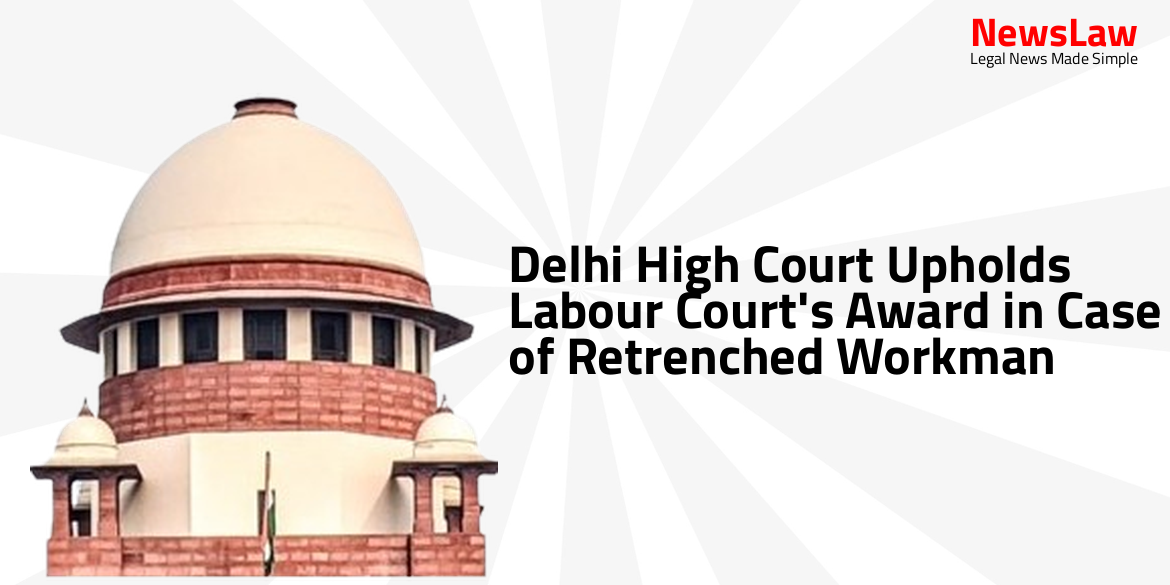The legal case delves into the crucial aspect of interpreting a notification under the ESI Act, focusing on the application of the law to specific establishments. The court’s thorough analysis highlights the significance of statutory language and the implications of proper interpretation. This summary sheds light on the complexities of legal proceedings and the importance of adhering to statutory provisions for comprehensive understanding and application of the law.
Facts
- M/s. Kay Dee Cold Storage Pvt. Ltd. was included under the coverage of E.S.I. Act via notification
- An appeal was filed challenging the decision of the EI Court
- Several villages including Lamargram, Ramnagar were included in the Tarapur villages area
- Show cause notice issued to remit contribution for the employees under the ESI Act
- Notification issued on 21.7.1999 specifying areas under Silchar Municipal Corporation
- Regional Director informed respondent about the ESI Act provisions being applicable to their factory
- Challenge in the appeal was against the judgment and order dated 1.12.2016
- Respondent moved Employees Insurance Court to challenge show cause notice and recovery steps
- Respondent claimed their factory area was not covered by the 21.7.1999 notification
- High Court set aside the order in favor of the appellants by the Employees Insurance Court.
- The factory of the respondent is located in Village Tarapur, outside the municipal limits of Silchar.
- Village Tarapur is not covered under the notification issued by the appellants under the ESI Act.
- The business of cold storage run by the respondent is considered as covered under the ‘manufacturing process’ as defined in the ESI Act.
- The respondent is required to make contributions under the ESI Act.
- The authorities correctly assessed the quantum of contribution payable for the employees in the establishment.
Also Read: Insurance Claim Repudiation due to Fire Incident: Court’s Legal Analysis
Issue
- The High Court interpreted the notification dated 21.7.1999 and concluded that it covers only the areas within the Silchar Municipal Board.
- The notification also mentions names of other areas/villages, including the Village of Tarapur, where the respondent’s factory is located.
- Village Tarapur is subdivided into different segments, with some parts falling within the Silchar Municipal Corporation and others within the Silchar Revenue Circle.
- The High Court’s interpretation led to the allowance of the RFA by setting aside the judgment of the E.I. Court.
Arguments
- The appellants argue that the High Court made an error in interpreting the notification dated 21.7.1999, which covers the entire village area of Tarapur.
- The appellants contest the exclusion of the area where the cold storage factory is located from the notification based on a certificate issued by the Silchar Municipal Board.
- Excluding the area of Ramnagar, Tarapur from the ESI Act coverage could set a precedent for others to claim exclusion as well.
- Mr. Goswami argues that penal implications under the ESI Act should be considered.
- Expanded interpretation of the notification is deemed unnecessary.
- The High Court’s interpretation of the notification dated 21.7.1999 in favor of the respondent is deemed correct.
Analysis
- The notification issued under Section 1(3) of the ESI Act, aimed to enlarge the coverage area well beyond the limits of the Silchar Municipal Corporation.
- The word ‘including’ in the notification was used as a word of enlargement, indicating an extensive territorial application of the ESI Act.
- The notification mentions the name of the village Tarapur twice, suggesting that the entire village area is notified for coverage under the ESI Act.
- The Employees’ Insurance Court should have conducted a proper investigation involving evidence from the parties, including the workmen concerned, to determine their employee status and entitlement to benefits.
- The High Court’s restrictive interpretation of the 21.7.1999 notification for the application of the ESI Act to smaller areas within the Silchar Municipal Corporation was deemed incorrect.
- Non-joinder of necessary parties can render a legal proceeding non-maintainable, as it goes to the root of the matter and could be fatal.
- The respondent’s failure to comply with the ESI Act requirements may result in penal action under the legislation.
- The notification was intended to cover areas beyond those within the Silchar Municipal Corporation, and proper punctuation interpretation is essential to determine the coverage.
- The punctuation in statutory notifications must be adhered to for correct interpretation.
- If the language used is clear, every word in the notification must be given effect.
- Two cases, South Central Railway Employees Cooperative Credit Society Employees’ Union and National Highways Authority of India, emphasize the importance of following the principles of interpretation in such cases.
- The decision of this Court in Employees’ State Insurance Corporation and Fertilizers and Chemicals Travancore Ltd. is relevant to the current case.
- There should be a necessity to include employees in proceedings under the ESI Act, as highlighted in Employees’ State Insurance Corporation.
- Justice R.V. Raveendran’s opinion on the word ‘includes’ in Ramanlal Bhailal Patel vs. State of Gujarat is cited, emphasizing an inclusive definition enlarges the meaning.
- Justice G.B. Pattanaik’s opinion in Union of India vs. Hansoli Devi stresses not brushing aside words in a statute as surplusage.
- The intended purpose of the ESI Act is to provide benefits to employees.
- In Delhi Gymkhana Club Limited vs. Employees’ State Insurance Corporation, impleadment of employees was a key issue.
- The notification clearly includes various areas beyond the territorial limits of the Silchar Municipal Board.
- The respondent’s establishment is found to be covered under the purview of the ESI Act based on the notification.
- The language used in the notification admits no exceptions as argued by the respondents.
- The mention of village Tarapur, where the respondent’s factory is situated, reinforces the inclusion of wider areas within the purview of the ESI Act.
- The language used in the notification emphatically indicates the drafter’s intention to include wider areas.
Decision
- The plain language of the notification settled the issue against the respondent
- As a result, the impugned decision was set aside
Case Title: THE EMPLOYEES STATE INSURANCE CORPORATION Vs. M/S KEY DEE COLD STORAGE PVT. LTD. (2022 INSC 602)
Case Number: C.A. No.-004159-004159 / 2022



